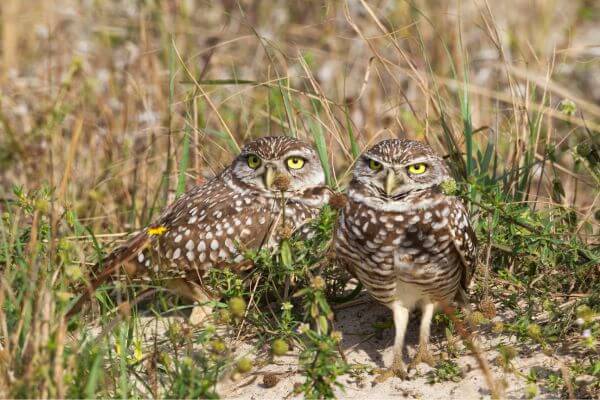The burrowing owl is one of the most enigmatic and intriguing birds that inhabit our forests and fields. It is also known by other names, such as armadillo owl, little hole owl and field owl. With her piercing eyes and quirky behavior, she leads us to explore a secret world full of mysteries and surprises. In this article, we’ll delve into the habitat and lifestyle of this magnificent bird, revealing details about its skills and survival strategies.

The Burrowing Owl’s Underground Habitat
One of the most striking characteristics of the burrowing owl is its preference for living in holes in the ground, rather than building nests in trees. These holes are dug by other animals, such as armadillos and rabbits, and the burrowing owl adapts them to create its home. This unique behavior offers protection from predators and adverse weather conditions. In addition, the underground environment provides a cool and safe environment.
In the subterranean environment, this bird finds not only safety and protection, but also a perfect refuge to raise its offspring. Holes in the ground provide a more stable temperature, protecting the hatchlings from the scorching heat of summer and the bitter cold of winter. The walls of the holes also provide sound insulation, making them ideal places for the hatchlings to develop. Within this subterranean world, she forges an intimate connection with nature, adapting in extraordinary ways to ensure the success of her species.
Hunting and Feeding Strategies
The burrowing owl is a highly skilled predator, capable of capturing a variety of prey for food. Their diet consists mainly of small mammals such as rats and mice, as well as insects and reptiles. It has exceptionally keen eyesight, allowing it to locate its prey even in low-light conditions. With fast and silent flights, it surprises its prey and captures it with sharp and powerful claws. These hunting strategies are essential for the survival of this nocturnal bird.
In addition to its remarkable hunting abilities, this bird has also developed adaptive strategies to secure its food supply. One of the intriguing tactics used is the creation of “pantries” in their territory. After capturing a prey, the burrowing owl can store the extra food in strategic places, such as tree branches or the edges of holes, to consume it later. This strategic food reserve allows it to feed even when game is scarce, ensuring its survival in times of scarcity. This adaptability and planning demonstrates remarkable intelligence and acumen.
Social Behavior and Reproduction
Although it is generally a solitary bird, it exhibits interesting social behavior during the breeding season. Couples of burrowing owls form strong bonds and work together to care for their offspring. Both parents participate in incubating the eggs and caring for the newborn chicks. This mutual dedication strengthens family ties and increases the offspring’s chances of survival.
During the breeding season, the burrowing owl exhibits remarkable social behavior by establishing a cooperative family structure. After mating, the burrowing owl couple takes on shared roles in incubating the eggs and caring for the young. While the female is mainly in charge of incubation, the male takes an active part in providing food for the female and the young. This joint collaboration strengthens family ties and ensures better protection and nutrition for the young. This exemplary behavior in raising their offspring highlights the importance of cooperation and mutual investment in the perpetuation of the species.
The Burrowing Owl and its Impact on the Ecosystem
The burrowing owl plays a crucial role in balancing the ecosystems it inhabits. Its presence controls the rodent population, helping to regulate the number of agricultural pests. In addition, their habit of occupying burrows abandoned by other animals contributes to the conservation of underground habitats, promoting diversity and ecosystem health.
In addition to the important population control of rodents, this species also has a significant impact on the food chain and on the dynamics of ecosystems. By feeding on insects and reptiles, it helps to regulate populations of these species, avoiding ecological imbalances. Furthermore, by occupying burrows abandoned by other animals, the burrowing owl plays a role as an ecosystem engineer, providing refuge for a variety of other species, such as small mammals, reptiles and invertebrates.
This beneficial interaction contributes to the diversity and resilience of subterranean habitats, playing an essential role in maintaining the health and balance of the ecosystems in which the burrowing owl is present.
Challenges and Conservation
Despite its remarkable adaptation and abilities, the burrowing owl faces a number of challenges that affect its survival and well-being. The destruction of natural habitats, rampant urbanization and the indiscriminate use of pesticides are some of the main threats facing this species. These factors result in the reduction of available areas for the construction of their nests and in the reduction of prey availability.
Burrowing owl conservation requires joint efforts. It is fundamental to promote the protection of natural areas and the implementation of sustainable agricultural practices. Furthermore, it is important to make the population aware of the importance of these birds and how to coexist harmoniously with them. Reintroduction projects and monitoring programs also play a crucial role in preserving the burrowing owl.
In order to ensure the continuity of this magnificent species, efforts are being made to study and better understand the habits and needs of the burrowing owl. Researchers are monitoring their populations, studying their reproductive behavior and developing effective conservation strategies. It is important to engage the community and raise awareness of the importance of the Burrowing Owl in our ecosystems.
In addition, habitat protection measures are also essential. The creation of protected natural areas, ecological corridors and the restoration of degraded habitats are important strategies for the preservation of the species. These actions aim to provide a safe and conducive environment for the reproduction, feeding and survival of these fascinating birds.
Ultimately, the burrowing owl invites us to explore its secret world, full of mysteries and wonders. Their presence is a reminder of the importance of biodiversity and the need to protect endangered species. By valuing and conserving, we are contributing to the preservation of a healthy balance in ecosystems and to the natural beauty of our planet.
So let’s admire the burrowing owl in its natural habitat, learn from its survival strategies, and take action to protect its existence. Only through our collective commitment to conservation can we ensure that this incredible bird continues to enrich our world with its secret world.

